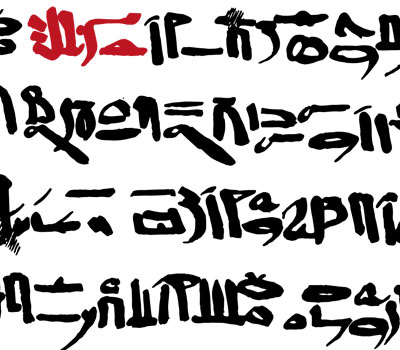Ancient Egyptian cursive scripts: Digital palaeography and systematic analysis of hieratic and cursive hieroglyphic writing
Links to the project
The subject of the interdisciplinary project, which combines egyptological research with methods from computer philology, consists of the ancient Egyptian scripts called Hieratic and cursive hieroglyphic script, both having been used alongside monumental hieroglyphic script for over 3000 years. The inventory of signs taken from selected texts is systematically and digitally recorded with different epochs, geographical regions, text genres, and writing materials (especially papyrus, linen, leather, wood, clay, and stone) from the period of 2700 BC to 300 AD being considered.
 Ancient Egyptian cursive scripts: Digital palaeography and systematic analysis of hieratic and cursive hieroglyphic writing
Ancient Egyptian cursive scripts: Digital palaeography and systematic analysis of hieratic and cursive hieroglyphic writingAncient Egyptian cursive scripts: Digital palaeography and systematic analysis of hieratic and cursive hieroglyphic writing
Host Academy
Academy of Sciences and Literature, Mainz
Location and federal state
Darmstadt, Hesse; Mainz, Rhineland-Palatinate
Type
Editions
Editions: Ancient History
Project number
II.C.26-1-2
The aim of the project is twofold. On the one hand, a digital palaeography is being composed. In the form of a database that offers multiple search options, it will include the entire sign repertoire of the cursive scripts, including ligatures and selected lexemes, along with extensive metadata to the sources. Major developmental stages of the cursive scripts are modularly analyzed. Access to the sources and the sign repertoire is provided through various formats of the material (originals, print and online editions, photographs, scans, facsimiles, or published palaeographies or sign lists).
The second focus of the project lies on systematic analyses of the scripts in order to answer various research questions, for instance regarding the development and developmental stages of the cursive scripts, their dependence on contemporaneous monumental hieroglyphic script, and their adaptation to specific needs and contexts. Measures taken to economize the scripts, including variability in character size and forms as well as writing direction, but also reduction, extension, and combination of individual characters (abbreviations, diacritics, ligatures) are also analyzed. The significance of the handwritings for the assignment to individual scribes, schools, regions, or periods is furthermore taken into account, as are material and practical aspects of writing by hand and the production of the writing materials. Finally, the functioning of the texts in the (re)organization and communication among officials, priests, and scholars is examined.
In addition to the classical research methods that the field of ancient Egyptian palaeography has at its disposal, algorithmic and digital evaluation methods are being applied in cooperation with computer philology. Didactic aspects and methods are considered as well: the project also includes modules on the practice of writing and methods to communicate knowledge of the cursive scripts to students.
Back to overview
